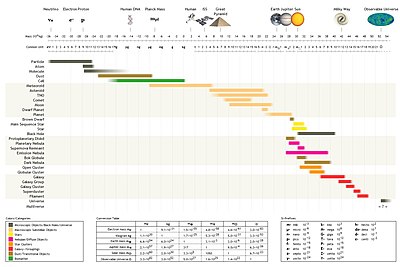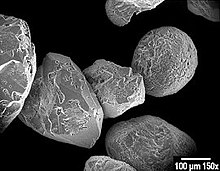
A | B | C | D | E | F | G | H | CH | I | J | K | L | M | N | O | P | Q | R | S | T | U | V | W | X | Y | Z | 0 | 1 | 2 | 3 | 4 | 5 | 6 | 7 | 8 | 9

To help compare different orders of magnitude, the following lists describe various mass levels between 10−67 kg and 1052 kg. The least massive thing listed here is a graviton, and the most massive thing is the observable universe. Typically, an object having greater mass will also have greater weight (see mass versus weight), especially if the objects are subject to the same gravitational field strength.
Units of mass
| Submultiples | Multiples | ||||
|---|---|---|---|---|---|
| Value | SI symbol | Name | Value | SI symbol | Name |
| 10−1 g | dg | decigram | 101 g | dag | decagram |
| 10−2 g | cg | centigram | 102 g | hg | hectogram |
| 10−3 g | mg | milligram | 103 g | kg | kilogram |
| 10−6 g | μg | microgram (mcg) | 106 g | Mg | megagram (tonne) |
| 10−9 g | ng | nanogram | 109 g | Gg | gigagram |
| 10−12 g | pg | picogram | 1012 g | Tg | teragram |
| 10−15 g | fg | femtogram | 1015 g | Pg | petagram |
| 10−18 g | ag | attogram | 1018 g | Eg | exagram |
| 10−21 g | zg | zeptogram | 1021 g | Zg | zettagram |
| 10−24 g | yg | yoctogram | 1024 g | Yg | yottagram |
| 10−27 g | rg | rontogram | 1027 g | Rg | ronnagram |
| 10−30 g | qg | quectogram | 1030 g | Qg | quettagram |
| Common prefixes are in bold face.[1] | |||||
The table at right is based on the kilogram (kg), the base unit of mass in the International System of Units (SI). The kilogram is the only standard unit to include an SI prefix (kilo-) as part of its name. The gram (10−3 kg) is an SI derived unit of mass. However, the names of all SI mass units are based on gram, rather than on kilogram; thus 103 kg is a megagram (106 g), not a *kilokilogram.
The tonne (t) is an SI-compatible unit of mass equal to a megagram (Mg), or 103 kg. The unit is in common use for masses above about 103 kg and is often used with SI prefixes. For example, a gigagram (Gg) or 109 g is 103 tonnes, commonly called a kilotonne.
Other units
Other units of mass are also in use. Historical units include the stone, the pound, the carat, and the grain.
For subatomic particles, physicists use the mass equivalent to the energy represented by an electronvolt (eV). At the atomic level, chemists use the mass of one-twelfth of a carbon-12 atom (the dalton). Astronomers use the mass of the sun (M☉).
The least massive things: below 10−24 kg
Unlike other physical quantities, mass–energy does not have an a priori expected minimal quantity, or an observed basic quantum as in the case of electric charge. Planck's law allows for the existence of photons with arbitrarily low energies. Consequently, there can only ever be an experimental upper bound on the mass of a supposedly massless particle; in the case of the photon, this confirmed upper bound is of the order of 3×10−27 eV/c2 = 10−62 kg.
| Factor (kg) | Value | Item |
|---|---|---|
| 10−67 | 1.07×10−67 kg | Graviton, upper bound (6×10−32 eV/c2)[2] |
| 10−40 | 4.2×10−40 kg | Mass equivalent of the energy of a photon at the peak of the spectrum of the cosmic microwave background radiation (0.235 meV/c2)[3] |
| 10−36 | 1.8×10−36 kg | 1 eV/c2, the mass equivalent of one electronvolt[4] |
| 3.6×10−36 kg | Electron neutrino, upper limit on mass (2 eV/c2)[5] | |
| 10−33 quectogram (qg) |
||
| 10−31 | 9.11×10−31 kg | Electron (511 keV/c2), the lightest elementary particle with a measured nonzero rest mass[6] |
| 10−30 rontogram (rg) |
3.0–5.5×10−30 kg | Up quark (as a current quark) (1.7–3.1 MeV/c2)[7] |
| 10−28 | 1.9×10−28 kg | Muon (106 MeV/c2)[8] |
| 10−27 yoctogram (yg) |
1.661×10−27 kg | Dalton (Da), a.k.a. unified atomic mass unit (u) |
| 1.673×10−27 kg | Proton (938.3 MeV/c2)[9][10] | |
| 1.674×10−27 kg | Hydrogen atom, the lightest atom | |
| 1.675×10−27 kg | Neutron (939.6 MeV/c2)[11][12] | |
| 10−26 | 1.2×10−26 kg | Lithium atom (6.941 Da) |
| 3.0×10−26 kg | Water molecule (18.015 Da) | |
| 8.0×10−26 kg | Titanium atom (47.867 Da) | |
| 10−25 | 1.1×10−25 kg | Copper atom (63.546 Da) |
| 1.6×10−25 kg | Z boson (91.2 GeV/c2)[13] | |
| 2.2×10−25 kg | Higgs boson (125 GeV/c2) | |
| 3.1×10−25 kg | Top quark (173 GeV/c2),[14] the heaviest known elementary particle | |
| 3.2×10−25 kg | Caffeine molecule (194 Da) | |
| 3.5×10−25 kg | Lead-208 atom | |
| 4.9×10−25 kg | Oganesson-294 atom, the heaviest known nuclide |
10−24 to 10−18 kg
| Factor (kg) | Value | Item |
|---|---|---|
| 10−24 zeptogram (zg) |
1.2×10−24 kg | Buckyball molecule (720 Da) |
| 10−23 | 1.4×10−23 kg | Ubiquitin, a small protein (8.6 kDa)[15] |
| 5.5×10−23 kg | A typical protein (median size of roughly 300 amino acids ≈ 33 kDa)[16] | |
| 10−22 | 1.1×10−22 kg | Haemoglobin A molecule in blood (64.5 kDa)[17] |
| 10−21 attogram (ag) |
1.65×10−21 kg | Double-stranded DNA molecule consisting of 1,578 base pairs (995 kDa)[18] |
| 4.3×10−21 kg | Prokaryotic ribosome (2.6 MDa)[19] | |
| 7.1×10−21 kg | Eukaryotic ribosome (4.3 MDa)[19] | |
| 7.6×10−21 kg | Brome mosaic virus, a small virus (4.6 MDa)[20] | |
| 10−20 | 3×10−20 kg | Synaptic vesicle in rats (16.1 ± 3.8 MDa)[21] |
| 6.8×10−20 kg | Tobacco mosaic virus (41 MDa)[22] | |
| 10−19 | 1.1×10−19 kg | Nuclear pore complex in yeast (66 MDa)[23] |
| 2.5×10−19 kg | Human adenovirus (150 MDa)[24] |
10−18 to 10−12 kg
| Factor (kg) | Value | Item |
|---|---|---|
| 10−18 femtogram (fg) |
1×10−18 kg | HIV-1 virus[25][26] |
| 4.7×10−18 kg | DNA sequence of length 4.6 Mbp, the weight of the E. coli genome[27] | |
| 10−17 | ~1×10−17 kg | Vaccinia virus, a large virus[28] |
| 1.1×10−17 kg | Mass equivalent of 1 joule[29] | |
| 10−16 | 3×10−16 kg | Prochlorococcus cyanobacteria, the smallest (and possibly most plentiful)[30] photosynthetic organism on Earth[31][32] |
| 10−15 picogram (pg) |
1×10−15 kg | E. coli bacterium (wet weight)[33] |
| 6×10−15 kg | DNA in a typical diploid human cell (approximate) | |
| 10−14 | 2.2×10−14 kg | Human sperm cell[32][34] |
| 6×10−14 kg | Yeast cell (quite variable)[35][36] | |
| 10−13 | 1.5×10−13 kg | Dunaliella salina, a green alga (dry weight)[37] |
10−12 to 10−6 kg

| Factor (kg) | Value | Item |
|---|---|---|
| 10−12 nanogram (ng) |
1×10−12 kg | Average human cell (1 nanogram)[38] |
| 2–3×10−12 kg | HeLa human cell[39][40][41] | |
| 8×10−12 kg | Grain of birch pollen[42] | |
| 10−11 | ||
| 10−10 | 2.5×10−10 kg | Grain of maize pollen[43] |
| 3.5×10−10 kg | Very fine grain of sand (0.063 mm diameter, 350 nanograms) | |
| 10−9 microgram (μg) |
3.6×10−9 kg | Human ovum[32][44] |
| 2.4×10−9 kg | US RDA for vitamin B12 for adults[45] | |
| 10−8 | 10−8 kg | Speculated approximate lower limit of the mass of a primordial black hole |
| 1.5×10−8 kg | US RDA for vitamin D for adults[46] | |
| ~2×10−8 kg | Uncertainty in the mass of the International Prototype of the Kilogram (IPK) (±~20 μg)[47] | |
| 2.2×10−8 kg | Planck mass,[48] can be expressed as the mass of a 2 Planck Length radius black hole | |
| ~7×10−8 kg | One eyelash hair (approximate)[49] | |
| 10−7 | 1.5×10−7 kg | US RDA for iodine for adults[50] |
| 2–3×10−7 kg | Fruit fly (dry weight)[51][52] |
10−6 to 1 kg
| Factor (kg) | Value | Item |
|---|---|---|
| 10−6 milligram (mg) |
2.5×10−6 kg | Mosquitoes, common smaller species (about 2.5 milligrams),[53] grain of salt or sand,[54] medicines are typically expressed in milligrams[55] |
| 10−5 centigram (cg) |
1.1×10−5 kg | Small granule of quartz (2 mm diameter, 11 milligrams)[56] |
| 2×10−5 kg | Adult housefly (Musca domestica, 21.4 milligrams)[57] | |
| 10−4 decigram (dg) |
0.27–2.0×10−4 kg | Range of amounts of caffeine in one cup of coffee (27–200 milligrams)[58] |
| 1.5×10−4 kg | A frame of 35mm motion picture film (157 milligrams)[59] | |
| 2×10−4 kg | Metric carat (200 milligrams)[59] | |
| 10−3 gram (g) |
1×10−3 kg | One cubic centimeter of water (1 gram)[60] |
| 1×10−3 kg | US dollar bill (1 gram)[61] | |
| ~1×10−3 kg | Two raisins (approximately 1 gram)[62] | |
| ~8×10−3 kg | Coins of one euro (7.5 grams),[63] one U.S. dollar (8.1 grams)[64] and one Canadian loonie (7 grams , 6.27 grams )[65] | |
| 10−2 decagram (dag) |
1.2×10−2 kg | Mass of one mole (6.02214×1023 atoms) of carbon-12 (12 grams) |
| 1.37×10−2 kg | Amount of ethanol defined as one standard drink in the U.S. (13.7 grams)[66] | |
| 2–4×10−2 kg | Adult mouse (Mus musculus, 20–40 grams)[67] | |
| 2.8×10−2 kg | Ounce (avoirdupois) (28.3495 grams)[59] | |
| 4.7×10−2 kg | Mass equivalent of the energy that is 1 megaton of TNT equivalent[59][68] | |
| 10−1 hectogram (hg) |
0.1-0.2 kg | An orange (100–200 grams)[69] |
| 0.142-0.149 kg | A baseball used in the major league.[70] | |
| 0.454 kg | Pound (avoirdupois) (453.6 grams)[59] |
1 kg to 105 kg

